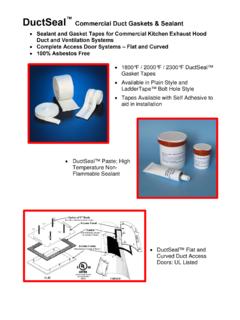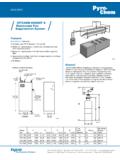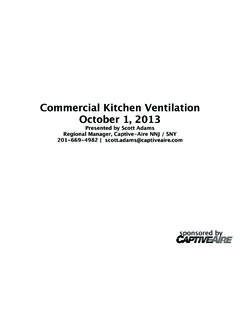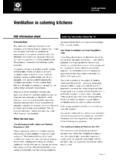Transcription of NEW YORK CITY DEPARTMENT OF …
1 1 NOTICE OF ADOPTION OF FINAL RULE DEPARTMENT of environmental protection NOTICE IS HEREBY GIVEN PURSUANT TO THE AUTHORITY VESTED IN THE COMMISSIONER OF THE DEPARTMENT OF environmental protection by Section 1403 (c) of the New york Charter and Sections 24-105 and of the New york city Administrative Code, that the DEPARTMENT of environmental protection has amended its rules to require control devices to reduce emissions from new commercial under-fired char broilers or from any existing or new chain-driven commercial char broilers used to cook more than 875 pounds of meat per week.
2 These amendments were proposed and published in the city Record on May 25, 2016 and one comment was received. A public hearing was held on June 29, 2016. No testimony was given at the hearing. Statement of Basis and Purpose Commercial char broilers throughout the five boroughs emit an estimated 1,400 tons of particulate matter per year. The DEPARTMENT of Health and Mental Hygiene estimates that those emissions contributed to more than 12% of premature deaths annually in 2005 to 2007 or 400 deaths per year in that period; if all commercial char broilers had had control technology installed, the reduction in ambient concentrations could have prevented nearly 350 of these premature deaths each year.
3 To reduce the amount of the emissions released by commercial char broilers, in 2015 the city Council amended Title 24 of the Administrative Code of the city of New york by adding a new Section , which prohibits the operation of any new commercial char broiler and any existing chain-driven commercial char broiler used to cook more than 875 pounds of meat per week unless it has an emissions control device that meets the requirements established by the Commissioner of the DEPARTMENT of environmental protection (DEP) (Local Law Number 38 for the year 2015, effective May 6, 2016).
4 DEP promulgates these rules, as required by Section , to establish requirements for the control of emissions from char broilers. In accordance with Section 24-105 of the Administrative Code, an advisory committee, which includes representatives of the restaurant industry and related industries, representatives of the environmental protection and environmental justice communities, and persons with expertise regarding the health effects of pollutants associated with cooking devices, has been consulted in the development of these rules.
5 In response to a comment received on the proposed rule, the final rule expands the testing methodology authorized for determining particulate matter emissions on commercial char 2 broilers. In addition to EPA Methods 5 and 202, South Coast Air Quality Management District Method may also be used. Section 2 of the rule amends Chapter 43 of Title 15 of the Rules of the city of New york to correct an error in the Air Code Penalty Schedule that became effective on May 11, 2016. Specifically, the proposed rules: Create a new chapter of DEP s rules for char broiler emissions requirements (Title 15, Chapter 37), Set forth the requirements for emissions control devices, and Establish maintenance, certification and recordkeeping requirements.
6 The Rule is authorized by Section 1043 of the New york city Charter and sections 24-105 and of the Administrative Code. The text of the Rule follows. Shall and must denote mandatory requirements and may be used interchangeably in the rules of this DEPARTMENT , unless otherwise specified or unless the context clearly indicates otherwise. Section 1. Title 15 of the Rules of the city of New york is amended by adding a new Chapter 37, to read as follows: Chapter 37 Emission Reduction Technologies for Char Broilers 37-01 Definitions.
7 Catalytic Oxidizer. Catalytic Oxidizer means an emissions control device which burns or oxidizes smoke and gases from the cooking process into carbon dioxide and water, using an infrastructure coated with a noble metal alloy. Chain-driven commercial char broiler. Chain-driven commercial char broiler means a commercial char broiler that is a semi-enclosed cooking device with a mechanical chain that automatically moves food through the device. Commercial char broiler. Commercial char broiler means a device that consists primarily of a grated grill and a heat source and that is used to cook meat, including beef, lamb, pork, poultry, 3 fish, and seafood, for human consumption at a food service establishment, as such term is defined in section of the New york city health code.
8 Electrostatic Precipitator (ESP). Electrostatic Precipitator (ESP) means a filtration device that removes fine particles, like dust and smoke, from a flowing gas using the force of an induced electrostatic charge minimally impeding the flow of gases through the unit. An ESP is a type of emissions control device. Emissions Control Device. Emissions control device means equipment that is installed on a commercial char broiler to reduce particulate matter emissions. Existing. Existing means installed before May 6, 2016.
9 Meat. Meat means tissue of an animal body that is used for food and includes, but is not limited to, beef, lamb, pork, poultry, fish, or seafood. New. New means installed on or after May 6, 2016. Particulate Matter. Particulate Matter or PM means any air or gas-borne material, except water, that exists as a liquid or solid. PM 10 means PM with an aerodynamic diameter equal to or less than 10 micrometers. Under-fired commercial char broiler. Under-fired commercial char broiler means a commercial char broiler that has a grill, a high temperature radiant surface, and a heat source that is located below the food.
10 Week. Week means a period of 7 consecutive days starting on Sunday, unless a different start day is specified in the registration filed pursuant to section 24-109 of the Administrative Code. 37-02 Requirements for Emissions Control Devices to Reduce Emissions from Existing or New Chain-Driven Commercial Char Broilers and New Under-Fired Commercial Char Broilers. (a) No person shall operate any new or existing chain-driven commercial char broiler to cook more than 875 pounds of meat per week unless a flameless catalytic oxidizer or other emissions control device that has been tested and certified in accordance with Sections 37-05 and 37-06 of this chapter has been installed.
















